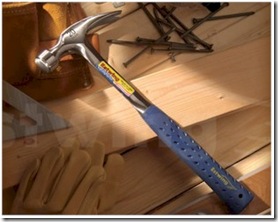Ferrari of Hammers
The brass-tacks business case for Dynamic Work is pretty straight forward – save money on under-used, un-used and mis-used office space and the stuff that goes in it. The benefits to carbon footprint, employee lives, collaboration and productivity, to name a few, are all just bonuses.
An important driver to these savings largely derive from the notion of ‘Pareto Efficiency.’ Pareto centres on allocating the right resources to the right usage. Also, sometimes referred to as the ’80-20 Rule’ referring to the notion that 80% of the benefits come from 20% of the resources. In the case of productivity, 80% of the productivity comes from 20% of the tools. As a result, productivity improves and costs drop if you invest twice as much in that 20% of the tools add remove the other 80% (though more practically you make the other lesser used ‘80%’ tools available on an as-needed pool basis).
Applied to the business workplace, all too many companies equip their workers with the equivalent of a standard, generic toolkit with pretty much all of the tools that they might need. Desk, chair, file cabinet, credenza, coffee machine, stationery, meeting rooms, work spaces, etc. Because they have to equip everyone with such a range of tools, businesses generally opt for the lowest common denominator versions of all of these tools. Maybe not bargain basement, but certainly not top of the range. Pareto suggests that if someone is using a ‘hammer’ 80% of the day, then getting that person the ‘Ferrari of Hammers’, even at the expense of taking away all of the other tools in the extreme instance, not only provides greater productivity return to the business, but also in most cases provides greater satisfaction to the worker.
This allocation is the heart of the win-win that provides the opportunity to businesses with Dynamic Work. Businesses can equip their staff with the ‘Ferrari of Hammers’ and they are happier (having such a great, central tool), more productive and in the end less costly (as the business pools the other tools as part of the bargain).
One of the pitfalls of poorly executed workplace transformations is when the company focuses solely on cost savings though pooling and consolidation. That approach becomes a pure ‘loss’ to the staff (they ‘lose’ 80% of the tools even though they only use them 20% of the time). Successful implementation of Dynamic Work has to involve a direct investment in a higher standard of ‘core tools’ in exchange for the surrender of those used less.
This principle is illustrated in my story ‘First Kill All the Office Buildings.’ The ‘tool’ in this instance was ‘facility for face to face collaboration’. The trade off was to jettison infrequently and non-optimally used cubicles, cavern-like conference rooms and expensive round the clock space for an exquisite venue and experience for a set time periodically.
The principle of Pareto has been applied extensively in the workplaces for employees’ own ‘life tools’, ie. their ‘benefits’, under the notion of ‘flexi-benefits’. The day care that is an important investment for a single parent may demand more of the benefit allowance than it would for an active single person who prefers the gym membership.
The IT functions of larger organisations are very familiar with this notion applied in the area of ‘systems virtualisation’. This technology has taken the IT world by storm in recent years with its gigantic ROIs and cost savings. The leaders in the field are VMware with Microsoft who both have countless case studies of big costs taken out of costly datacentres in very short time period. Again, the principle of Pareto applies. Previously, many systems all had an array of antiquated, sub-optimal, dedicated processing power. Virtualisaton ‘trades in’ the dedicated ‘tools’ (CPU, storage, chassis, etc.) for a shared or virtual system of the highest standard (upgraded hardware, upgraded software, etc.).
Footnote. The consensus seems to be that the ‘Ferrari’ of hammers is an ‘Estwing’ pictured above. It costs $23 on Amazon ($47 RRP) versus $10 for a ‘standard’ Stanley model. $13 premium might seems like an extravagance of nearly double the price. But for a carpenter’s central tool that would last nearly a lifetime, the incremental costs is easily covered by doing without ‘owning’ a couple of lesser used tools. If the hammer lasts 10 years and is used 50% of the time, then that is an incremental costs of 1 cent per day.
